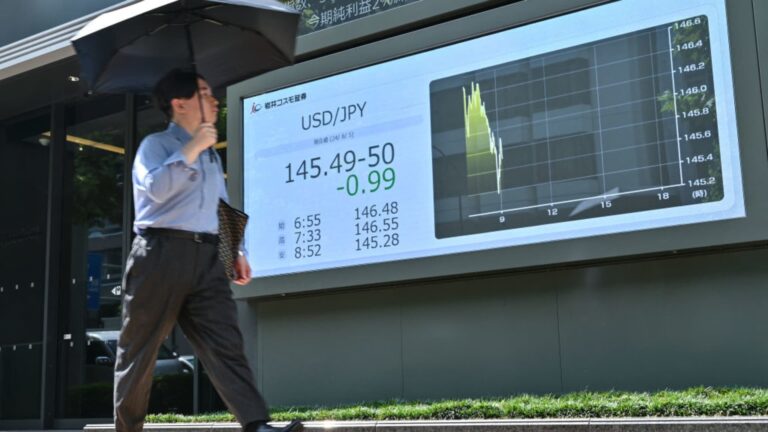A pedestrian walks past a display board showing the currency exchange rate between the US dollar and the Japanese yen, along a street in Tokyo on August 5, 2024.
Richard A. Brooks | Afp | Getty Images
The U.S. dollar is likely to continue to drift lower against the Japanese yen over the coming months, according to one market strategist, particularly as the yen-funded “carry trade” could have plenty of room to run.
Geoffrey Yu, senior EMEA market strategist at BNY Mellon, told CNBC’s “Street Signs Europe” on Wednesday that dollar weakness was expected to persist against a number of major currencies through to the end of the year.
His comments come after another day of dollar selling on Tuesday, with market participants poised for the release of preliminary revisions to U.S. labor data on Wednesday. The figures could present a “downside risk” to the dollar, according to analysts at Dutch bank ING.
The dollar was trading 0.6% higher at 146.09 yen at around 11:50 a.m. London time on Wednesday, shortly after dipping below the closely watched 145 yen level for the first time since Jan. 6, Reuters reported. The yen has risen sharply in recent weeks, pointing to a sustained unwinding in the carry trade.
Carry trades refer to operations wherein an investor borrows in a currency with low interest rates and reinvests the proceeds in higher-yielding assets elsewhere.
The foreign exchange strategy has been hugely popular in recent years, particularly as investors expected the Japanese yen to remain cheap and for Japanese interest rates to stay low.
Asked how much lower the U.S. dollar could go, Yu replied, “It depends on against what [currency]. Dollar-yen, you know, pick a number, right? So, we’re happy to see it go on the 130 [yen] handle, at least heading towards year-end, so much more downside there.”
He added, “[The] yen is actually still very underheld, according to our data. Euro-dollar, I think $1.05 is probably a more reasonable level, although still quite aggressive by the way by current standards. But that would be a target of mine heading towards year-end, as data really starts to turn in a negative manner.”
Yu said that the rate of the dollar against the Chinese yuan was likely to tick higher because the People’s Bank of China (PBOC) “needs to ease” monetary policy.
“But [the] dollar against the higher yielding currencies, like the Mexican peso, for example, I would expect the dollar to actually outperform,” he said.
What next for the yen carry trade?
The yen-funded carry trade began aggressively unwinding earlier this month as interest rate hikes from the Bank of Japan strengthened the yen — and contributed to a dramatic sell-off in global markets.
Strategists have since been reluctant to give the all-clear to the rapid unraveling of carry trades, warning investors that the unwind is far from over.
BNY Mellon’s Yu echoed this view on Wednesday.
“We’re still seeing significant underheld short yen positions within our data, especially from the cross-border community. We did see a surge of yen cash demand, liquidity demand, during the early weeks of August, but that has sort of stabilized as well,” Yu said.
“I think once the Fed path is in the price, and then we get the issue of changing the Japanese government as well, and we set out policy in the medium term in dollar-yen. That could trigger further unwinding but not in such a volatile manner as we saw two weeks ago,” he added.


